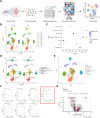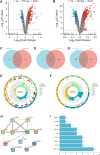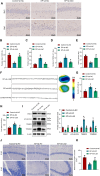Impact of LITAF on Mitophagy and Neuronal Damage in Epilepsy via MCL-1 Ubiquitination
- PMID: 39764629
- PMCID: PMC11705406
- DOI: 10.1111/cns.70191
Impact of LITAF on Mitophagy and Neuronal Damage in Epilepsy via MCL-1 Ubiquitination
Abstract
Objective: This study aims to investigate how the E3 ubiquitin ligase LITAF influences mitochondrial autophagy by modulating MCL-1 ubiquitination, and its role in the development of epilepsy.
Methods: Employing single-cell RNA sequencing (scRNA-seq) to analyze brain tissue from epilepsy patients, along with high-throughput transcriptomics, we identified changes in gene expression. This was complemented by in vivo and in vitro experiments, including protein-protein interaction (PPI) network analysis, western blotting, and behavioral assessments in mouse models.
Results: Neuronal cells in epilepsy patients exhibited significant gene expression alterations, with increased activity in apoptosis-related pathways and decreased activity in neurotransmitter-related pathways. LITAF was identified as a key upregulated factor, inhibiting mitochondrial autophagy by promoting MCL-1 ubiquitination, leading to increased neuronal damage. Knockdown experiments in mouse models further confirmed that LITAF facilitates MCL-1 ubiquitination, aggravating neuronal injury.
Conclusion: Our findings demonstrate that LITAF regulates MCL-1 ubiquitination, significantly impacting mitochondrial autophagy and contributing to neuronal damage in epilepsy. Targeting LITAF and its downstream mechanisms may offer a promising therapeutic strategy for managing epilepsy.
Keywords: LPS‐induced TNF‐alpha factor; MCL1; epilepsy; mitochondrial autophagy; neuroprotection; ubiquitination regulation.
© 2025 The Author(s). CNS Neuroscience & Therapeutics published by John Wiley & Sons Ltd.
Conflict of interest statement
The authors declare no conflicts of interest.
Figures







Similar articles
-
LITAF (Lipopolysaccharide-Induced Tumor Necrosis Factor) Regulates Cardiac L-Type Calcium Channels by Modulating NEDD (Neural Precursor Cell Expressed Developmentally Downregulated Protein) 4-1 Ubiquitin Ligase.Circ Genom Precis Med. 2019 Sep;12(9):407-420. doi: 10.1161/CIRCGEN.119.002641. Epub 2019 Aug 28. Circ Genom Precis Med. 2019. PMID: 31462068 Free PMC article.
-
Inhibition of USP30 Promotes Mitophagy by Regulating Ubiquitination of MFN2 by Parkin to Attenuate Early Brain Injury After SAH.Transl Stroke Res. 2025 Apr;16(2):448-466. doi: 10.1007/s12975-023-01228-3. Epub 2023 Dec 26. Transl Stroke Res. 2025. PMID: 38147294 Free PMC article.
-
Trim17-mediated ubiquitination and degradation of Mcl-1 initiate apoptosis in neurons.Cell Death Differ. 2013 Feb;20(2):281-92. doi: 10.1038/cdd.2012.124. Epub 2012 Sep 14. Cell Death Differ. 2013. PMID: 22976837 Free PMC article.
-
Chronic Deletion and Acute Knockdown of Parkin Have Differential Responses to Acetaminophen-induced Mitophagy and Liver Injury in Mice.J Biol Chem. 2015 Apr 24;290(17):10934-46. doi: 10.1074/jbc.M114.602284. Epub 2015 Mar 9. J Biol Chem. 2015. PMID: 25752611 Free PMC article.
-
Building and decoding ubiquitin chains for mitophagy.Nat Rev Mol Cell Biol. 2018 Jan 23;19(2):93-108. doi: 10.1038/nrm.2017.129. Nat Rev Mol Cell Biol. 2018. PMID: 29358684 Review.
Cited by
-
NLRP3 inflammasome inhibits mitophagy during the progression of temporal lobe epilepsy.Sci Rep. 2025 May 10;15(1):16341. doi: 10.1038/s41598-025-01087-y. Sci Rep. 2025. PMID: 40348802 Free PMC article.
References
-
- Zhong W., Johnson C. M., Cui N., Xing H., Wu Y., and Jiang C., “Effects of Chronic Exposure to Low Dose THIP on Brainstem Neuronal Excitability in Mouse Models of Rett Syndrome: Evidence From Symptomatic Females,” Neuropharmacology 116 (2017): 288–299, 10.1016/j.neuropharm.2017.01.002. - DOI - PubMed
MeSH terms
Substances
Grants and funding
LinkOut - more resources
Full Text Sources
Medical

